I have seen – and driven – the future, and it is electric.
And I found it in a place you normally wouldn’t go looking, Faro, in the heart of Portugal’s Algarve region. When my plane touched down there, earlier this week, I was looking forward to some pleasant driving time. It’s beautiful countryside with lots of winding, lightly traveled mountain roads that pass through pastoral villages almost lost in time. As for the vehicle I’d crossed the ocean to test out, the new Jaguar I-Pace was, if nothing else, distinctively styled, both inside and out. Whether it would deliver that sometimes intangible concept we describe as “fun-to-drive” was going to be the real question.
When the first mass market battery-electric vehicles came to market early in this decade, about the most you could say for them was that they were environmentally friendly. They were slow, stodgy and required you to keep a constant eye on the range gauge lest you find yourself stranded miles from home. Tesla kicked it up a big notch by offering range comparable to a gas-powered vehicle and, with the optional Ludicrous Mode, blindingly fast acceleration. That said, the Models S, X and 3 each have their shortfalls. For most of us, they’re still not quite serious alternatives to conventional vehicles.
The I-Pace, on the other hand, changes the equation. It is easy to fall back on clichés when trying to describe Jaguar’s first all-electric model, but it truly is electrifying, and by virtually every measure, it not only sets a benchmark for future battery-electric vehicles but also shows that BEVs can pose a direct challenge to conventional gas-powered models when it comes to not only design, interior space, comfort and utility, but performance and handling, as well.
Since the Toyota Prius and the original Honda Insight came to market nearly two decades ago, manufacturers have debated whether to opt for unique styling that blared “green” at first glance, or to go with more conventional designs. The 2019 Jaguar I-Pace is clearly not just another SUV from a visual standpoint, but there’s clear logic – and function – behind its distinctive design.
(Jaguar I-Pace pricing undercuts Tesla’s Model X. Click Here for the story.)
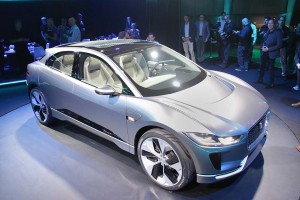
The production I-Pace remains close to this concept version first revealed at the 2016 LA Auto Show.
Traditional vehicles, powered by internal combustion engines, need to dedicate significant space up front for their drivetrains. Ironically, most early hybrids, plug-ins and pure electric models demanded even more sacrifice by mounting their battery packs where they’d gobble up passenger and cargo space. The gen-1 Chevy Volt’s T-shaped pack ran right down the middle of the cabin.
First introduced in November 2016, the concept I-Pace was the hit of that year’s Los Angeles Auto Show, in part because the design team aimed to exploit some of the qualities unique to electric propulsion. Like Tesla, Jaguar opted to mount virtually all of its electric drive components under the load floor, in a skateboard-like platform. That includes its 90 kilowatt-hour lithium-ion battery pack, as well as the twin electric motors mounted one per axle.
The arrangement has a number of advantages, including the fact that the hefty battery pack rides as low as possible which means the I-Pace actually has a lower center of gravity than Jaguar’s other two, conventionally powered SUVs, the E-Pace and bigger F-Pace.
But perhaps the biggest surprise is just how roomy the package is, since the interior claws back a chunk of space normally devoted to the engine compartment – where there’s now a small “trunk.” While I-Pace has a modest exterior footprint, about the size of Porsche’s compact Macan, it has as much passenger and cargo space as a stretch version of Jaguar’s full-size XJ sedan.
The British automaker is by no means the first manufacturer to adopt a cab-forward design. But, part of the challenge was to make I-Pace look like, well, a Jaguar, a brand whose vehicles normally opt for long snouts and rearward cabins that speak of dynamic performance and handling. The production SUV’s design team, led by Wayne Burgess, had a doubly difficult challenge: they not only had to reinterpret that sense of muscularity but also deliver the most aerodynamic shape Jaguar has ever come up with, each count they cut wind resistance adding up to better performance and improved range.
What they’ve come up with has the look of a tall, but sporty, Kammback. You’ll immediately spot traditional Jaguar cues, starting with the familiar broad oval grille and J-Blade headlamps, up front, and the narrow, almost slit-like taillights. A closer inspection reveals a few distinct differences from the E- and F-Pace, however.
Up front, what looks like a muscle car’s hood scoop is actually an air extractor. A driver actually can look through it and see the road ahead. There are functional air curtains and the grille has active shutters that remain closed until cooling air is needed for the battery pack, motors and electronics. The I-Pace is also relatively slab-sided, though it doesn’t appear it thanks to shoulder line that kicks upward, along with dark inserts above the rockers, that create the impression of Jaguar’s classic coke bottle curves.
All in, the I-Pace has a drag coefficient of 0.29, Jaguar’s best ever and a striking feat for any SUV. And that, in turn, is one of the reasons it delivers an estimated range of around 240 miles per charge. While not a much for a Tesla Model X with its 100 kWh battery, it’s nonetheless a solid figure in the still-emerging world of long-range electric vehicles.
The aero-swept design does ask passengers to make some compromises, notably a bit of gymnastics required to climb into the back seat. But once inside, you find loads of head, shoulder, leg and knee room.
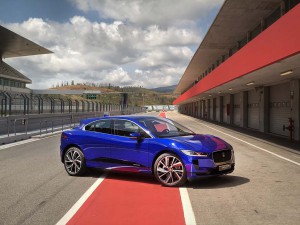
Unlike Tesla's current offerings, Jaguar has integrate cooling systems to allow the I-Pace to keep running flat out as long as there's charge left.
You also find luxurious appointments that further take advantage of the I-Pace platform’s layout – which eliminates the center tunnel normally needed for a rear- or all-wheel drive vehicle. The development team replaced it with a large center console with massive storage space.
There are three large screens inside the I-Pace, starting with the reconfigurable gauge cluster that can be customized to deliver extensive driver information, including turn-by-turn navigation and range information. (There’s also an optional head-up-display.) The center stack, meanwhile, is dominated by the new Jaguar InControl Touch Pro Duo, which includes a 10-inch upper display handling a range of infotainment functions, and a 5.5-inch lower touchscreen that primarily operates climate control.
The navi system not only can plan out a route but also calculate how much energy it will require, factoring in driving style and even the topography of the route. There are plenty of smarts behind the I-Pace and it will even learn a motorist’s habits and desires, taking only a couple weeks to figure out such things as the radio stations you like to listen to. I-Pace, meanwhile, integrates with the Jaguar smartphone app to control things like charging times and cabin pre-heating. You can also operate many functions by pairing with your Amazon Alexa voice assistant.
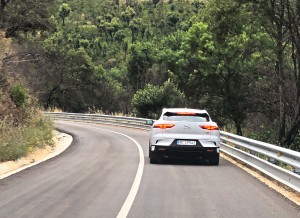
No, he hasn't hit his brakes, though I-Pace will warn following motorists when regen kicks in during single-pedal driving.
Jaguar’s creative use of the skateboard platform yields more than just a roomy interior. It also contributes to the sort of dynamic performance and handling that redefines the genre of the electrified vehicle.
One key advantage of electric motors is that they can deliver incredible horsepower and torque – and do so the moment they start to spin. The torque curve is essentially square. Combined, the two motors on the I-Pace are rated at 394 horsepower and 512 pound-feet of torque, Under normal driving, the rear motor does the heavy lifting, but the front motor kicks in, all but instantaneously, depending upon both traction needs and driver input. And kick is the right word because if you stomp pedal to metal, you are immediately thrust back into I-Pace’s well-bolstered seat as if you were driving a classic muscle car.
That said, the rest of the ride is uncannily smooth, reflecting both the linear acceleration of the electric motors and the fact that there’s a single-speed gearbox.
(Click Here for more about the new Jaguar I-Pace.)
Jaguar engineers put a premium on eliminating what has been called “the stumps in the swamp,” the many odd and often unpleasant sounds that can emerge from under the hood of an electric vehicle – the ticks, pops, whines and whirs of mechanical and electrical systems normally covered up by the road of an internal combustion engine. Under all but the most aggressive acceleration, the I-Pace is almost eerily quiet, but put foot to the floor and you might think you’re piloting the Millennium Falcon. Jaguar also has integrated into I-Pace an active noise system that lets you tune precisely what sounds you get.
There is little doubt Jaguar is proud of what it has accomplished. It provided us with two full days behind the wheel, far more time than with the typical first drive. And it baked in plenty of different driving opportunities, including freeeways, curvy mountain roads, an afternoon at the F-1-rated Autodromo Internacional Algarve track, and even some off-road stretches. Plunging bumper-deep into a mountain stream is not something one typically would think to do in an electrified vehicle.
What was particular surprising about driving the Jaguar I-Pace is how nimble it is. You feel like you’re driving one of the marque’s traditional sport sedans, rather than a big SUV – and an electric one, at that. There’s no sense of the big battery pack’s mass. If anything, the lower center of gravity helps enhance the driving experience so you feel like you can whip around even the tightest corners more smoothly than with the conventionally powered Jaguar E- and F-Pace SUVs.
There are some differences in driving the electric SUV, notably the ability to do much of your work with just the throttle pedal. In the settings screen on the InControl system, you’ll find an option that lets you choose between two settings for regenerative braking. This feature allows the I-Pace to recapture energy normally lost while braking or coasting. But in Full mode it effectively functions like dropping a gas vehicle’s transmission down a couple gears.
It takes some time to get the feel for One Pedal Driving, learning how to modulate the throttle as you head in and out of curves. But whether on a mountain road or the 15-corner Autodromo track, we soon found we could skip the brake entirely in many situations. And, ironically, the process not only helped us improve handling and lap times but also extend range by recapturing energy.
Though we’ll have to wait to see what Porsche delivers with the upcoming Taycan, the production version of the Mission E concept, we’ve yet to find any electric vehicle that offered a more thrilling ride. Indeed, few vehicles, period, running under $100,000. Though “only” rated at 4.5 seconds 0 to 60, a fair bit slower than a Tesla Model X with optional Ludicrous Mode, the I-Pace has nothing to be ashamed of here.
What’s significant is that it doesn’t suffer from the limitations Tesla doesn’t talk about. The California carmaker’s products can’t run lap after lap, or even engage in too many Ludicrous Mode launches, because its batteries and motors will overheat. Jaguar has given I-Pace three separate cooling systems, and plenty of ways to channel air where its needed, so it can keep running, pretty much flat out, until you’ve drained the battery.
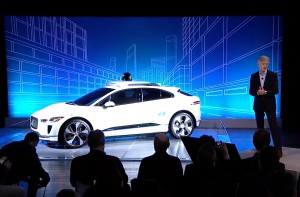
In March, Waymo CEO John Krafcik announced the company's new autonomous ride-share service will acquire up to 20,000 I-Pace SUVs.
And when that happens, you can get an 80% top-off using one of the many new 100-kilowatt Level 3 chargers in about 40 minutes. Using a home 240-volt system takes as much as 12.6 hours if the battery is drained to empty, but that isn’t likely to happen often.
Industry experts anticipate most BEV buyers will keep their vehicles plugged in overnight, generally starting the day with a full battery, but a 240-mile pack means that you’re no longer limited to staying close to home. With thousands of high-speed chargers expected to be dotting the country over the next couple years, you could make a run from LA to Chicago or New York to Washington and charge up during a break for lunch or dinner.
During our time in the Algarve, we got to drive several different versions of the new 2019 Jaguar I-Pace, including the almost fully loaded First Edition, priced at $85,900 plus delivery fees. A base version of the I-Pace starts at $69,500. Considering the bigger (outside) Jaguar F-Pace starts around $42,000, that’s a hefty premium – though the far less impressive Tesla Model X starts at $10,000 more than a base I-Pace. And Jaguar’s electric SUV has a lot more creature comforts, such as heated rear seats.
(To see more about Porsche renaming the Mission E the Taycan, Click Here.)
As we plunged into that mountain stream we couldn’t help but think of the irony that a company once known for its trouble-plagued electrical technology could help transform the world of electric propulsion. But if our trip to the Algarve is any indication, the 2019 Jaguar I-Pace provides a benchmark for the emerging electric vehicle segment, proving BEVs really can do everything a gas vehicle can – and more.

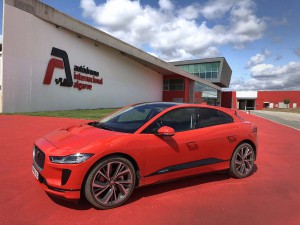
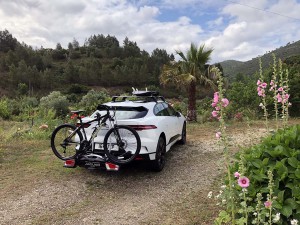
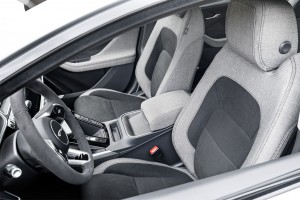
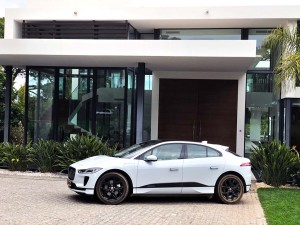
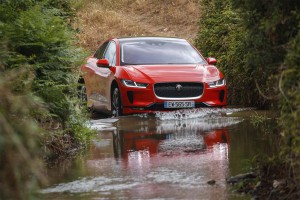
Amazing how a trip across the pond influences a review.
LOL…if you think spending three sleepless nights to Europe and back influences a review then you haven’t done rapid-fire travel.
Paul E.
No mention on Teslas Nationwide charging network. ICE manufactuers just cant get over the old business model of not paying for charging. Until they do, better to buy a Tesla.
The reality is that 90%+ of BEV owners do and will continue to charge at home. Ironically, the longer the range the less critical public charging will be, as the majority start the day out at home or apartment complex with full charges and, with 200+ miles of range, seldom need to plug in during the day. However, the number of public Level 2 and 3, and now Level 3+ chargers is exploding. Electrify America, using the $bils from VW, is setting up something not unlike the Tesla Supercharger network — and at much more familiar locations, ie WalMarts.
Don’t get me wrong, I think public charging systems are essential, and I know personally that there are times I need to go beyond my vehicle’s range, but it is far from frequent if I charge overnight and, increasingly, I can find chargers in most locations as readily as the Supercharger network.
Recall, the free juice deal from Tesla is going away, starting with Model 3, so that advantage is disappearing.
Also, a number of the new Level 3+ chargers offer substantially higher power than Superchargers. We’re now seeing 100 kW and higher public systems that will slash time-connected. So, as with almost everything, Tesla’s supposed advantages are being minimized or worse.
Frankly, anyone who is comparing a quality-poor Model X v the Jaguar I-Pace should take a long pause.
Paul E.
Looks like a nice little car there. Comparing a four passenger car that you have to do gymnastics to get into the back seat to a seven passenger SUV that you can walk into on price without mentioning the vast difference seems a bit biased, no? The Model X is 14″ longer, over 14″ WIDER, and 5″ taller. When configured as a five passenger vehicle it has 88.1 cubic feet of cargo space. The I-Pace has 23.5 and seats four.
Yeah, the much larger Model X costs $10,000 more…and comes with lifetime free supercharging. Also has autopilot available…And when Tesla does come out with an SUV around the size of the Jaguar it will cost over $20,000 less, so I hope Jaguar can find some ways to cut costs on the next two years.
Model X also is described as the normally Tesla-friendly Consumer Reports as having the single-worst quality and having the lowest reliability of any vehicle on the market. (Tied with the Cadillac Escalade.) As to cargo space, you are comparing apples-to-oranges: seats up/seats down. And I would rather have to duck my head, personally, but know that the back doors actually close. The falcon wing design for the Model X has been a disaster that even Elon Musk has said was a mistake.
Paul E.
All valid points. Loooong pause. Ok out in western united states charging points other than tesla chargers are few and far between. And charging at dealerships are not the answer.Kodak thought their business model of making money from every film photo would alway prevail. Today nobody makes money from people taking photo digitially. Same goes with charging in the future, with solar powered charging stations testla or not the cost of energy goes drastically down. The latest wholesale price of solar is below 2cents per kilowatt. And the charging station can be put anywhere with solar and batteries for night. No tanker trucks needed to refill and no grid needed. The long view is the infrastructure needed for fossil is not the same electric.
Another long pause. If the ice manufactuers are depending on government to provide infrastructure like they did at the start of the freeway and highway system they will behind the one manufactuer that does tesla.I would buy any vehicle that has the most chargers. That just happens to be Tesla. Or any manufactuer that makes a deal to use Tesla chargers. Im sure it wouldnt be cheap, but the lead that tesla has is going to cost a lot more to catch up to. Buying a tesla even if as pointed out model three as a option will eliminate many frustrations until the old business model of fossil pay as you go is put to rest.